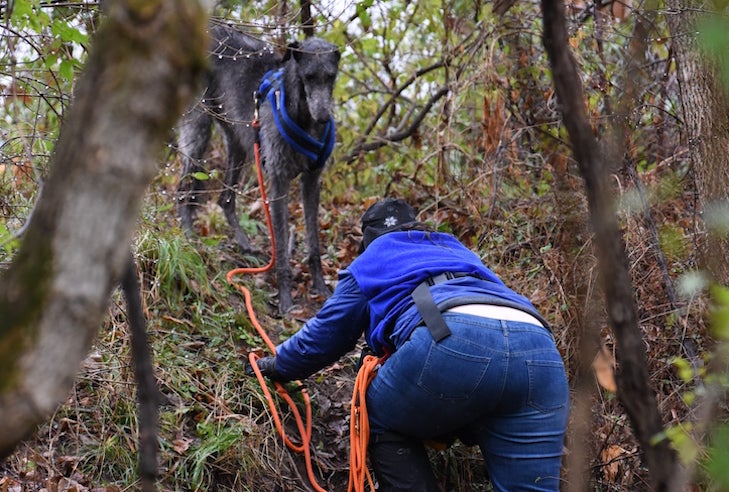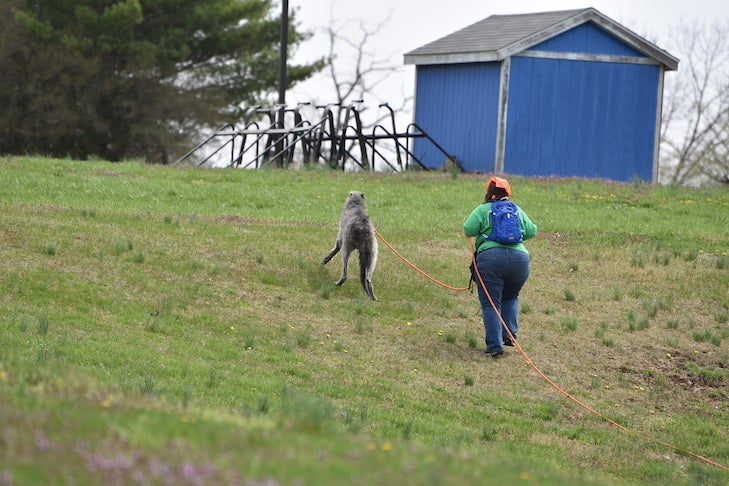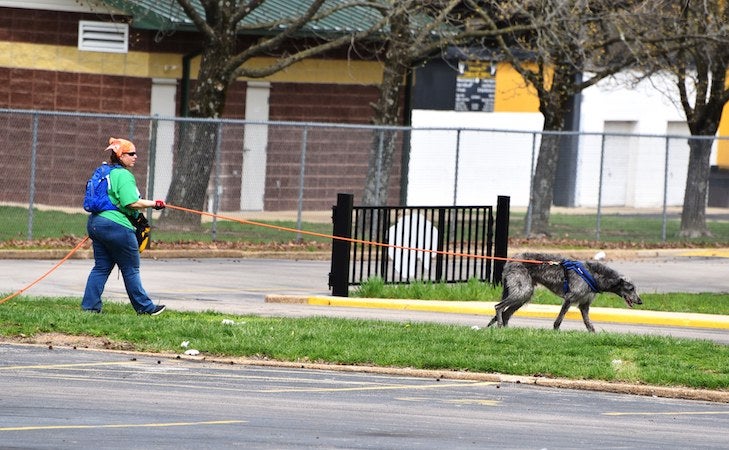
Being the “first” to achieve something takes a lot of determination and tenacity, something that Scottish Deerhound Brodie and his owner, Linda Beisswenger, know all too well.
In St. Louis, Missouri, Brodie came to Beisswenger as just a puppy. Previously, Beisswenger competed in AKC Tracking with her Borzoi. “I just fell in love with Tracking and I’m still in love with it,” Beisswenger explains.
This inspired her to begin training Brodie in Tracking.
Scottish Deerhounds, known as the “Royal Dog of Scotland,” ascended from ancient Greyhounds. While they are regarded as one of the tallest breeds, they have a gentle, yet polite temperament. When Beisswenger and Brodie first started training, no other Scottish Deerhound had achieved the AKC Champion Tracker (CT) title. It became their goal to change that. Compared to her Borzoi, Beisswenger says Brodie tracks more methodically. “He was slow to get started. I would get nervous and start talking too much, but then realized it was off-putting to him,” she explains.
Getting Started in AKC Tracking
Tracking allows dogs to demonstrate their natural ability to follow a human’s scent. It’s great for canines who need to stimulate their minds and bodies, and while training is very important, dogs only have to qualify once successfully in order to earn each title. In other sports like Agility or Obedience, a dog may have to qualify three or more times. “One of the greatest things about tracking is that the dog is in charge and you have to follow the dog. It’s something they can do because you are playing into a dog’s trait. It’s something they excel at. They are amazing with scent and all dogs can compete on that level,” Beisswenger says.
In March 2016, Brodie achieved his Tracking Dog (TD) title. December of the same year, Brodie achieved his Tracking Dog Excellent (TDX) title. The TDX title is earned when a dog passes a test that presents difficult challenges. It will show the dog has the ability to discriminate between different human scents and possesses the stamina, perseverance, and courage to do so under a wide variety of conditions. A TDX track must be at least 800-1,000 yards in length, the scent on the track will be 3-5 hours old, and there must be 5-7 turns along the path.

A Major Setback
It seemed Beisswenger and Brodie were on a roll until May 2017, when everything came to a halt. Brodie fractured his front leg and the injury was labeled as catastrophic. After the injury, Brodie went to rehab and Beisswenger soon learned that he had lost all flexibility in his front leg. Because of this, he acquired a stiff gate and nerve damage appeared in his rear legs from antibiotics. All of this trauma left Brodie with an unbalanced walk, where he appeared wobbly.
As you can imagine, this could have discouraged Beisswenger and Brodie from continuing their Tracking career. Tracking tests have a variety of ground conditions that dogs and handlers will need to navigate while following the scent. Beisswenger describes this event with a concise memory, explaining the depth of Brodie’s surgery. “He had a fracture and it was repaired with a 6-hour surgery. We went through a lot of pain, 3 months down the line we found out he re-broke his leg. One time I woke up and he was laying on the kitchen floor because he couldn’t get up,” Beisswenger states.

Never Giving Up
Despite the setbacks they faced in 2017, by the following year Beisswenger was determined to get Brodie entered back into the sport, to compete. “Once everything was over, I always dreamed he would get 100 percent better. I would look at him and think he was sound enough and he was okay, then other times I would say he isn’t,” Beisswenger explains. As the recovery lasted several months, she started training a younger dog and every once in awhile, would train Brodie.
When fall of 2018 came around, Beisswenger asked a Tracking Field Representative to analyze Brodie for possible re-entry. Though Beisswenger and Brodie both wanted to perform, she knew that because of his disabled gait, the answer would probably be “no” because dogs with lameness or any irregularity of movement may not compete. After an examination, the representative answered, confirming Beisswenger’s prediction.
The team never gave up hope — Brodie continued playing with his owner and practiced for possible re-entry to Tracking in the future. In the meantime, the pair went hiking and enjoyed plenty of time in the outdoors.
Scottish Deerhounds like Brodie need plenty of exercise and love companionship. That’s part of why Beisswenger continued exercising him in the absence of entering Tracking tests.

Finding Their Way Back to Tracking
After plenty of downtime away from Tracking, things started to look up. During the winter of 2018, Beisswenger discovered a potential change to the AKC Tracking Regulations. The Tracking Regulations were amended to allow dogs with physical disabilities to enter AKC Tracking tests effective on April 1, 2019. The time flew by and Brodie was entered in the Gateway Tracking Club’s April 7 Variable Surface Tracking Test.
Beisswenger had friends contact her stating that they had a disabled dog who was going to be able to track. “When they asked me to compete, I said that we were all in, we are going to go for it. I didn’t expect him to pass,” Beisswenger says. She describes the day as extremely hot — she brought two water bottles, an ice pack, and a cold cloth wrapped around the bottles.
In AKC Tracking, a dog is able to earn five potential titles: Tracking Dog (TD), Tracking Dog Urban (TDU), Tracking Dog Excellent (TDX), Variable Surface Tracking (VST), and Champion Tracker (CT). Should your dog earn three titles (TD or TDU, TDX, and VST) they will be named a Champion Tracker (CT).
During the event, she explains the type of course and the variable conditions that the pair faced. “He was doing his normal start and I was biting my tongue to not speak as long as I could and then I said ‘Brodie, let’s go’ because I didn’t know what he was thinking,” Beisswenger says. “Then he started tracking. It was at a high school and they had prom the night before, resulting in the trash outside. He just wanted to look at the trash.”
As the two made their way through the course, they eventually came across the first article. Beisswenger explains that Brodie is always thrilled when he finds the first article. After multiple water stops and breaks, Brodie eventually found the second article.
Nearing the end of the course, the two faced an incline, a hill that would put a strain on Brodie’s leg. “I kept encouraging him. He lied down for a second, but as soon as I saw him lie down, I thought that he couldn’t continue. He can’t continue and I’m not going to make him,” Beisswenger adds. Once she called his name, he stood up and continued in what she calls his “moment of truth”.
She describes a huge parking lot in front of him with two directions to choose from. “I thought to myself — I don’t care, no matter what this dog does I’m following him. I kept pouring water on him, but no matter what way he goes I was just going to follow. He walks over and goes exactly right. I marched right behind him,” Beisswenger explains.
After his “moment of truth”, Brodie discovered the final article. “It was one hour and nine minutes that he had tracked in the heat,” Beisswenger adds. She describes that Brodie seemed very tired and turned immediately happy when they gathered to take their picture.
Making Tracking History
At the Gateway Tracking Club event in April, Brodie earned the VST title and became a Champion Tracker, making him the first of his breed to achieve that accomplishment.
“It is with so much pride that I report that Brodie earned his [AKC] VST Tracking title that day, becoming first Scottish Deerhound to be recorded by AKC as a Champion Tracker,” Beisswenger says. “It was wonderful to have my fellow club members present and it was especially exciting to have my mentors, my friends and supportive judges there to reward his effort with a pass. I encourage everyone with an active, abled, or disabled dog to give tracking a try. You and your dog will love it.”
By overcoming challenges, and thanks to regulation changes, Brodie was able to pave a way for many other dogs to succeed in Tracking. “It was a wonderful moment we had together. We always say to trust your dog, you have to have faith,” Beisswenger states.
Want to Try AKC Tracking?
AKC Tracking is a great sport and enrichment activity for dogs that enjoy hikes and being outdoors. If you’re interested in getting started, the AKC Club Search allows you to find a Tracking Club near you and the AKC Event Search will show you upcoming Tracking events.

